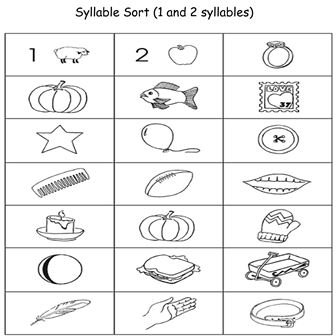Teaching Syllables to Kindergarten: Lesson on Counting Syllables
Counting Syllables
Kindergarteners need to know just the basics of how to count syllables orally and they will learn it in no time with this fun lesson.
Prior Knowledge:
Students will need to know what a vowel is. I wrote a lesson on teaching vowels too, which is in this series of articles below.
Teach:
A syllable is part of a word that contains one vowel sound. On chart paper, show the students an example of how to count syllables using the word, September. Sep- is the first syllable, -tem is the second syllable, and -ber is the third syllable. Have the students clap the word September and count the three syllables in the word. Have the students find the vowel in each part of the syllable and circle it. Practice with plenty of other words as the children usually enjoy counting syllables.
There is no need for the students to circle syllables in words independently at this age, but your advanced students will try. The trickiest part about learning syllables for Kindergarteners is that they stretch the vowel sounds, like haaand. Showing them that these short words have one vowel will help.
Practice With Names:
Next, show the students how to collect data, create a graph from the data and how to use the data in a practical sense by graphing syllables in their names.
Create a T-chart to collect data. The title should read, Student’s Name and Number of Syllables in My Name. Write each student’s name in column form. Be sure to include your own name with the class. Clap the syllables and chart the number of syllables in each class member’s name. Be sure to stress to the students that we are not counting the letters in their names (this is a different lesson).
Next, create a graph and graph the information (data) that you collect about the number of syllables in their names. Compare results from the data. How many students in the class have the highest or lowest number of syllables? Which is greater or less than?
Now, show the students how data works by playing a game.
Create index cards with the number of syllables in their names, for example, Laurie would have the name and the number 2 on it. Cards will have the number 1, 2, 3, or 4, according to the data in the class (this information is transferred right from the chart). You can write the cards out ahead of time or you can elicit the help of your eager Kindergarteners. Have them print their name and the number of syllables in their name on the card.
Pass the cards out. Continue until all students have a card in hand with the number of syllables in their name. The students have to find all of the people in the class with the same number of syllables in their names and stand together in a group. This is a bit chaotic, but fun to watch how Kindergarteners organize themselves.
Once the students have formed the groups, count the number of students in each group (have a student help if you’d like). Read the chart and graph to compare to see if the results are the same on the chart and graph as the groups that they have created. Kindergarteners will understand this practical activity.
Assess:
**
Really an informal assessment is in order. You will be able to observe which children are clapping correctly, if they can tell you the number of syllables in their name, and if they participate in the graphing activity.
Once students learn syllables well you can do a syllable sort like the picture shown.
Extend With a Home and School Connection:
Assign the students to write all of their family member’s names on a sheet of paper and count the number of syllables in each family member’s name. Students really enjoy this activity and parents are usually surprised that Kindergarteners are already learning about syllables.
These are teacher created activities from experience teaching a Kindergarten class. I know your students will enjoy them.
Photo Credit: https://img.docstoccdn.com/thumb/orig/38850862.png
This post is part of the series: Learn About Vowels and Syllables
For more fun lessons about vowels and syllable games, read more.
